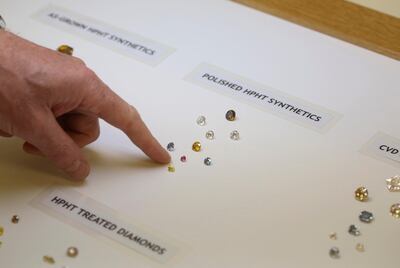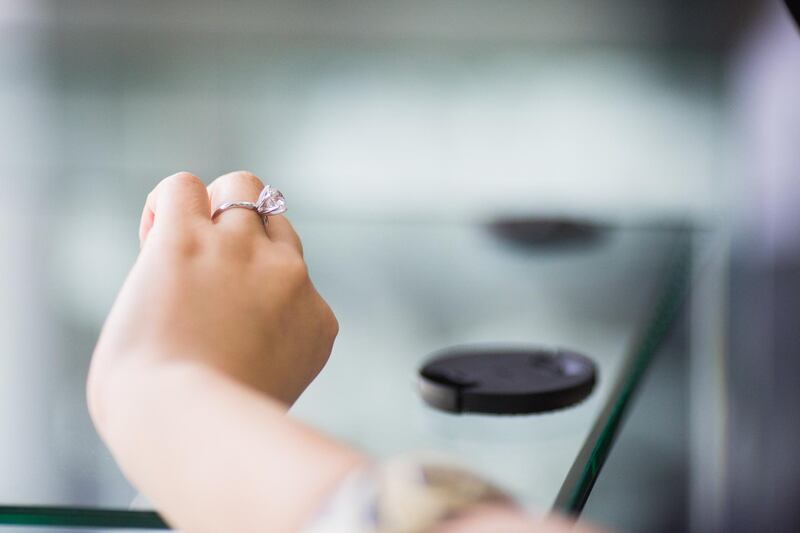De Beers, a company synonymous with high-quality precious stones, recently announced its plans to produce and sell man-made diamonds.
From comparing it to “dropping an atomic bomb” on the lab-created diamond industry, to lauding the move for furthering market transparency, or dismissing its impact altogether, the move has polarised industry opinion. However, from a buyer and jewellery aficionado’s point of view, it’s imperative to understand what exactly lab-grown diamonds are, and why we should care about them in the first place.
Diamonds cultivated in a laboratory mirror the appearance, and have the same chemical and physical composition, as the crystallised carbon creations formed under the Earth's surface. They are just as "real", at least from a scientific point of view.
Nature does not want diamonds to form any longer
"Growing diamonds works a bit like a greenhouse," explains Vishal Mehta, chief executive of Singapore-based Ila Technologies. "We start by planting diamond seeds, which are simply carbon fragments of pre-existing diamonds, inside a growth chamber. The conditions are replicated for the seeds to undergo natural crystallisation, with the same heat, pressure and other elements found under the Earth's surface, resulting in coloured or colourless type IIa diamonds (the rarest and purest grade). The whole process takes up to 12 weeks."
Until now, such stones were primarily used for research and industrial functions, with even bigwig companies such as De Beers contributing their lab-grown stones to the drilling, mining and semi-conductor sectors. Speaking to The National for a previous article on the subject, Mehta explains that a handful of companies have made the move to cultivate such diamonds for adornment because natural diamonds are getting rarer each year. "For example, diamond mines no longer produce type IIa stones that are said to constitute only 2 per cent of total diamonds produced by mines," he says.
According to the Environmental Impact Analysis: Production of Rough Diamonds report, published by Frost & Sullivan, harmful carbon emissions produced by mined diamonds are estimated at 57,000 grams per carat. Monitored diamonds, on the other hand, emit 0.028 grams per carat. And the often-tragic conditions of mining communities, and the now small but still deadly black market for blood diamonds, also do not come into play when you're dealing with lab-made diamonds.
Why the price difference?
What does matter, however, is the cost. No matter how similar the traits of man-made diamonds, they cannot be compared to the stones that are formed in the belly of our planet. How can an object that takes three months to form be as treasured as much as one that can take up to three billion years, no matter how similar they are? Scarcity, the reason why lab-grown stones may well be the future, is why diamonds are deemed so precious to begin with.
However, with purse strings tightening, natural resources depleting and sustainable luxury making its needs felt, lab-grown diamonds are increasingly being seen as satisfying a number of financial and ethical constraints. They are also gradually being deemed sufficiently authentic and precious in their own right.
With De Beers jumping into the fray, that appreciation hangs in the balance. The company has been crystal clear in its communication about the perceived value of synthetic stones. "They're not to celebrate life's greatest moments, but they're for fun and fashion. We're not pretending they're unique or rare. If you lose it, it's not going to hurt as much as if you lost the real thing. It is not for those great moments in life [when] you want something inherently precious," said representatives in a statement released by the 130-year-old conglomerate.
The gemstone giant claims that it will sell its man-made diamonds – marketed as a new brand, Lightbox Jewellery – for a tenth of the price of a mined gem, starting from US$800 (Dh2,938) per carat. The idea is to appeal to a new generation of buyers, as well as to promote these stones as a "fun piece of fashion jewellery", effectively undermining their value vis-a-vis naturally formed stones. Also, this estimate is much lower than the current price that lab-grown diamonds claim.
It is estimated that a type IIa diamond grown in the lab would cost Dh12,000 per carat (compared to Dh40,000 for a naturally occurring one); the Diamond Foundry (endorsed by actor Leonardo DiCaprio), for instance, sells its one-carat synthetic diamonds for about Dh12,850. These rates are about four times more than what De Beers claims it will charge. The De Beers-branded stones will quite likely find more takers, but the decision to market them as a "fun but non-precious option" will also further chip away from the gradually ascending significance and acceptance of man-made stones.

Industry analyst Paul Zimnisky, who accredited the De Beers move with seismic proportions, says: “This move will not completely destroy the lab-created diamond industry forever, but it stops it in its tracks and allows De Beers to take over control. I don’t think De Beers ever wanted to be in the lab-created diamond business, this is more of a strategic move to protect its natural diamond business by taking control of the lab-created business and steering the identity, to one of a distinctly different product class from natural diamonds.”
However, he is quick to add: “De Beers has a long history of persevering in the modern consumer economy. The company is extremely strategic – I wouldn’t bet against them. This was a bold move – there will be some collateral damage, but I think it was the right move given the circumstances.”
For others, the decision is a step forward in educating end users about the co-existence and monetary value of each type of stone. Imagine for a minute if you realised at some point that the solitaire on your engagement band had been grown artificially by a team of scientists – doesn’t ring quite as romantic, does it?
What's next in the diamond industry?
Dev Shetty, president and chief executive of Fura Gems, a mining and marketing company in Dubai, says: "We believe that both natural and synthetic diamonds can co-exist, as long as proper disclosures are made. The industry needs to be far more transparent and forthcoming with information. I feel that the De Beers strategy should work, because they are demarcating their target audience. The fact that synthetic diamonds exist is not a secret and there is no need to shy away. What is really needed is that consumers should know what they paying for. With De Beers entering the synthetic-diamond market, we believe that transparency, messaging and disclosure will only get better."
_______________________
Read more:
Diamonds are a risk-free investment
De Beers' entry into synthetic diamonds shakes up lab stones producers
The lab-grown gems threatening the diamond industry
_______________________
Then there are those who believe the resale market is unlikely to be affected by this decision in the near future. "These are two distinct markets and there is no doubt a place for both. [But] jewellery auctions cater to collectors who seek gemstones of high quality and rarity, which are often regarded as wonders of nature," says Daniela Mascetti, jewellery expert and deputy chairperson of Sotheby's Jewellery Europe. "Operating as we do on the secondary market, we don't see the demand for great natural diamonds being impacted by synthetic diamonds, which are specifically designed to meet demand for 'affordable fashion jewellery that may not be forever, but is perfect for right now', as stated by De Beers themselves," she adds.
Quite like its natural counterpart, a man-made diamond should physically last forever, and the final choice rests with you, the consumer. On the one hand, the story behind the million-year-old stones is undeniably alluring for some, while on the other, factors such as environmental and human impact, and prohibitive prices rank far higher for others. "A happy balance for me," investment banker Priya Kapoor says, "is to have a combination of both types. While I wouldn't want my engagement ring or my investment pieces to be made from man-made stones, a woman can never have or wear too many diamonds. If I can add to my collection with a piece that is cheaper and just as nice to look at, I would definitely buy it."






